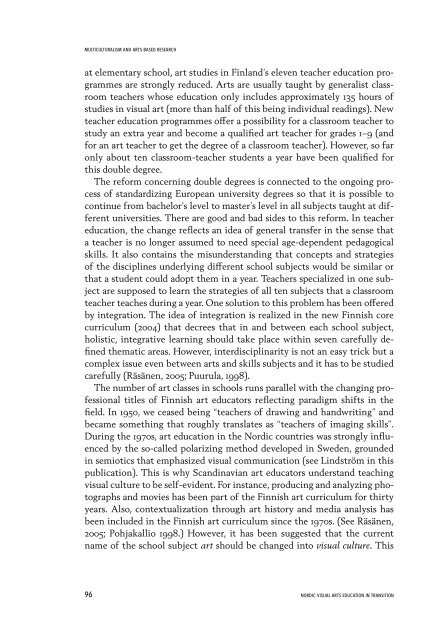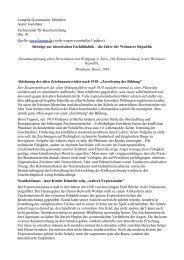Research in Visual Arts Education - The National Society for ...
Research in Visual Arts Education - The National Society for ...
Research in Visual Arts Education - The National Society for ...
You also want an ePaper? Increase the reach of your titles
YUMPU automatically turns print PDFs into web optimized ePapers that Google loves.
MULTICULTURALISM AND ARTS-BASED RESEARCH<br />
at elementary school, art studies <strong>in</strong> F<strong>in</strong>land’s eleven teacher education programmes<br />
are strongly reduced. <strong>Arts</strong> are usually taught by generalist classroom<br />
teachers whose education only <strong>in</strong>cludes approximately 135 hours of<br />
studies <strong>in</strong> visual art (more than half of this be<strong>in</strong>g <strong>in</strong>dividual read<strong>in</strong>gs). New<br />
teacher education programmes offer a possibility <strong>for</strong> a classroom teacher to<br />
study an extra year and become a qualified art teacher <strong>for</strong> grades 1–9 (and<br />
<strong>for</strong> an art teacher to get the degree of a classroom teacher). However, so far<br />
only about ten classroom-teacher students a year have been qualified <strong>for</strong><br />
this double degree.<br />
<strong>The</strong> re<strong>for</strong>m concern<strong>in</strong>g double degrees is connected to the ongo<strong>in</strong>g process<br />
of standardiz<strong>in</strong>g European university degrees so that it is possible to<br />
cont<strong>in</strong>ue from bachelor’s level to master’s level <strong>in</strong> all subjects taught at different<br />
universities. <strong>The</strong>re are good and bad sides to this re<strong>for</strong>m. In teacher<br />
education, the change reflects an idea of general transfer <strong>in</strong> the sense that<br />
a teacher is no longer assumed to need special age-dependent pedagogical<br />
skills. It also conta<strong>in</strong>s the misunderstand<strong>in</strong>g that concepts and strategies<br />
of the discipl<strong>in</strong>es underly<strong>in</strong>g different school subjects would be similar or<br />
that a student could adopt them <strong>in</strong> a year. Teachers specialized <strong>in</strong> one subject<br />
are supposed to learn the strategies of all ten subjects that a classroom<br />
teacher teaches dur<strong>in</strong>g a year. One solution to this problem has been offered<br />
by <strong>in</strong>tegration. <strong>The</strong> idea of <strong>in</strong>tegration is realized <strong>in</strong> the new F<strong>in</strong>nish core<br />
curriculum (2004) that decrees that <strong>in</strong> and between each school subject,<br />
holistic, <strong>in</strong>tegrative learn<strong>in</strong>g should take place with<strong>in</strong> seven carefully def<strong>in</strong>ed<br />
thematic areas. However, <strong>in</strong>terdiscipl<strong>in</strong>arity is not an easy trick but a<br />
complex issue even between arts and skills subjects and it has to be studied<br />
carefully (Räsänen, 2005; Puurula, 1998).<br />
<strong>The</strong> number of art classes <strong>in</strong> schools runs parallel with the chang<strong>in</strong>g professional<br />
titles of F<strong>in</strong>nish art educators reflect<strong>in</strong>g paradigm shifts <strong>in</strong> the<br />
field. In 1950, we ceased be<strong>in</strong>g “teachers of draw<strong>in</strong>g and handwrit<strong>in</strong>g” and<br />
became someth<strong>in</strong>g that roughly translates as “teachers of imag<strong>in</strong>g skills”.<br />
Dur<strong>in</strong>g the 1970s, art education <strong>in</strong> the Nordic countries was strongly <strong>in</strong>fluenced<br />
by the so-called polariz<strong>in</strong>g method developed <strong>in</strong> Sweden, grounded<br />
<strong>in</strong> semiotics that emphasized visual communication (see L<strong>in</strong>dström <strong>in</strong> this<br />
publication). This is why Scand<strong>in</strong>avian art educators understand teach<strong>in</strong>g<br />
visual culture to be self-evident. For <strong>in</strong>stance, produc<strong>in</strong>g and analyz<strong>in</strong>g photographs<br />
and movies has been part of the F<strong>in</strong>nish art curriculum <strong>for</strong> thirty<br />
years. Also, contextualization through art history and media analysis has<br />
been <strong>in</strong>cluded <strong>in</strong> the F<strong>in</strong>nish art curriculum s<strong>in</strong>ce the 1970s. (See Räsänen,<br />
2005; Pohjakallio 1998.) However, it has been suggested that the current<br />
name of the school subject art should be changed <strong>in</strong>to visual culture. This<br />
96 NORDIC VISUAL ARTS EDUCATION IN TRANSITION



